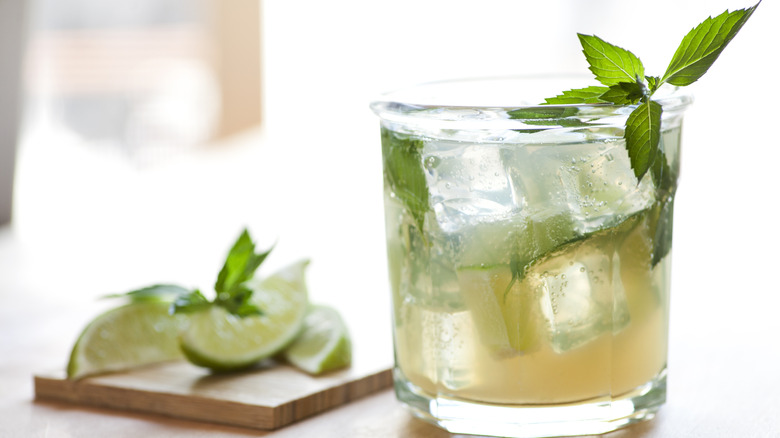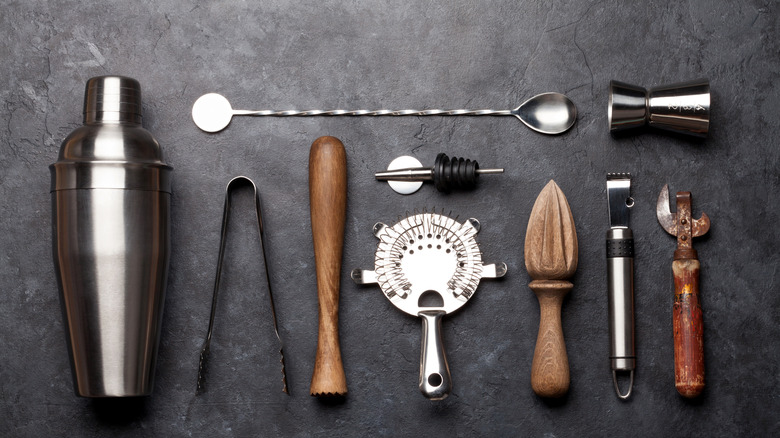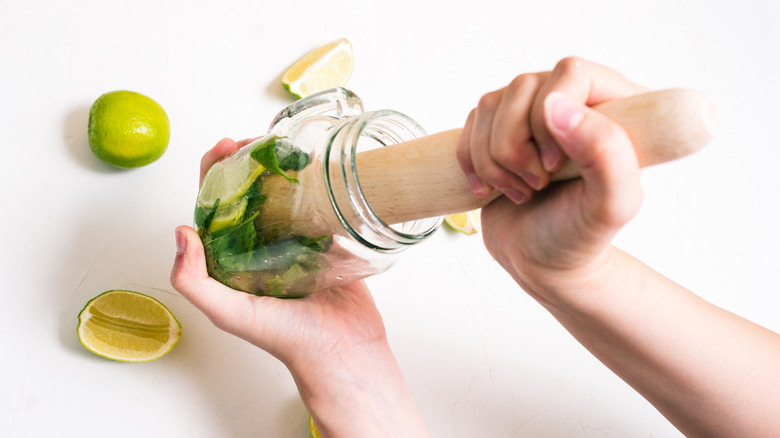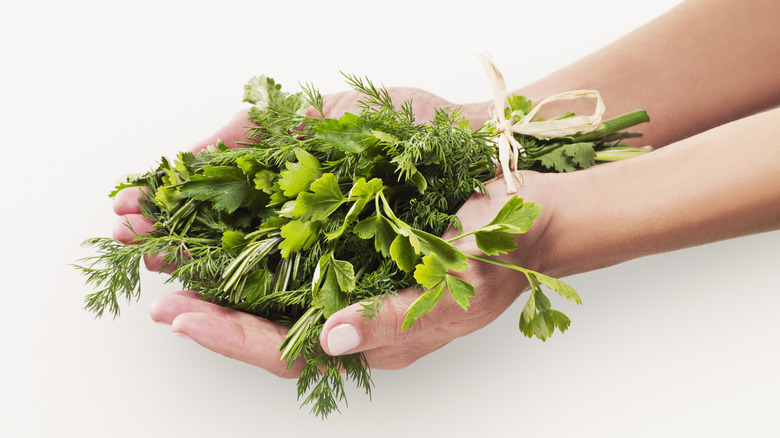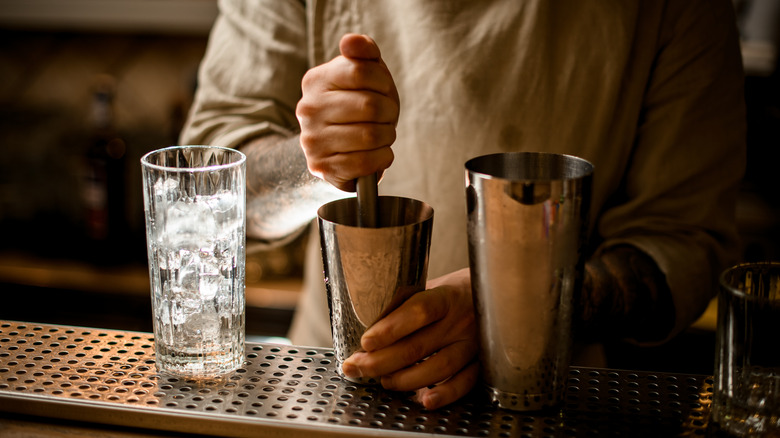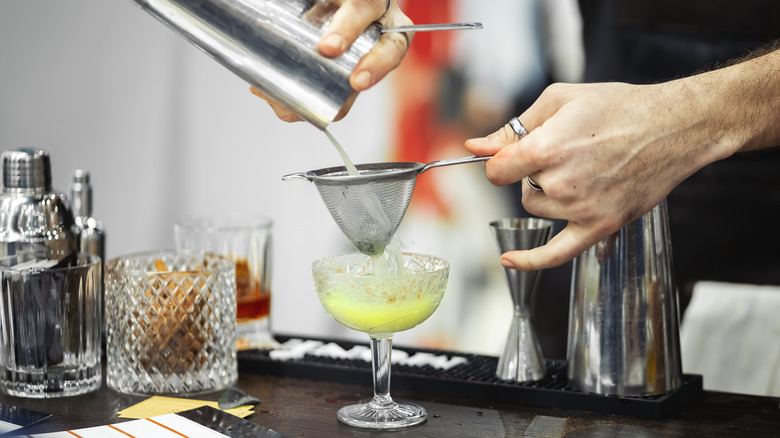How To Muddle Mint And Other Herbs For Cocktails
Adding fresh herbs to drink recipes is one of the easiest ways to upgrade a homemade cocktail to a swanky bar-caliber drink that you'd expect to pay upwards of $20 for. Mint is traditionally used in classic drinks like a summertime mojito or a mint julep, famously enjoyed during the Kentucky Derby in May, but herbs belong in cocktails all year long. Smashes, caipirinhas, mules, and all the delicious variations we want in the colder months are brighter and fresher with the addition of herbs.
To fully appreciate their herbaceousness, the plant's essential oils need to be released. Similar to squeezing a lime wedge to release the juice before dropping it into the glass, simply putting the herb in the drink won't do, which is why mixologists muddle.
Muddling is a way to infuse the ingredient's aroma and taste into the beverage. Like a cook's mortar and pestle, muddlers bruise fruit and herbs to release more flavor into the drink. It elevates the drinking experience, so as you lift the cocktail to your mouth, you can first appreciate its aromas.
Tools needed for muddling herbs
Muddling can be done directly in the glass you serve the drink in or in a cocktail shaker. If muddling in a glass, it's best to avoid delicate, thin-walled ones since they may chip or break during the process, especially if you use a metal muddler. This method is preferred when preparing one or two cocktails or keeping the herbs in the glass like a mojito.
Of course, herbs can be muddled in cocktail shakers, too. There are two types: Boston shakers and cobblers. Boston shakers come with a metal and glass cup — whereas cobblers are all metal. It's a matter of preference which one you use. However, cobblers tend to stick when the two pieces get cold (which happens quickly), requiring a firm whack to separate the cups.
Some shakers come with a strainer that generally has holes large enough for small pieces of herbs to escape. If you don't want stuff floating in the drink, opt for a Hawthorne mesh strainer that's fine enough to catch small particles.
Choosing the right muddler
You can purchase a wood, metal, or silicone muddler that resembles a mini baseball bat, but it's unnecessary. A wooden spoon handle is less flashy but works just as well. Since you are gently grinding the ingredients, which can be grainy like sugar cubes, avoid using anything with a finish, which can wear off in the cocktail. Again, an unfinished wooden spoon or even a French rolling pin will do.
To reach the bottom of a highball or shaker, use a muddler roughly eight to 12 inches long and thin enough to fit in narrow glasses. Since we want to bruise the leaves but not pulverize them, the muddler should have a smooth, round, beveled end and be comfortable in your hand. Avoid muddlers that look like meat tenderizers. They will tear the leaves, which can make the drink bitter. Overextracting and releasing an herb's chlorophyll will ruin the drink and leave you with tiny green pieces of mint in your teeth.
Place the herbs in the glass
Place clean, dry herbs in the bottom of a glass or shaker. Leave the herbs whole, stem and all. Think beyond mint and try adding any fresh herb you grow or have access to. Woodsy rosemary is a delicious addition to tequila cocktails like margaritas or palomas and adds warmth in the colder months. Basil, lavender, and thyme work well with clear spirits like vodka and gin, but all herbs can be used to make different flavor combinations. Use them fresh or burn heartier herbs like rosemary to add a charred, smokey element to cocktails.
If the recipe calls for fruit or sugar, add it to the glass with the herbs. This will add friction and help release the herb's essential oils. Avoid adding ice at this point, as it will prematurely dilute your beverage as it crushes.
Don't feel limited to fresh herbs, either. Dried pods like cardamom, star anise, and Chinese five spice can also flavor hot and cold drinks. The spice can steep if the beverage is meant to be served warm or crack the pod with the muddler for a cold cocktail. Similarly, a small amount of freshly muddled ginger has a significant impact on a cocktail's flavor.
The proper muddling technique
Muddling cocktails is a gentle, not a violent action, which can be a ruinous mistake for your cocktail. We don't want to shred the herbs into a chiffonade — but rather slightly bruise them to softly coax the oils out. Gripping the muddler in one hand, press down on the herbs, giving them a slight twist. Lift and repeat this movement half a dozen times. Each time you lift, reposition the muddler, so you can reach all the herbs and no one section gets pulverized. When you are done, the herbs should remain intact, and the cocktail should be deliciously fragrant.
Add the remaining ingredients
Once all the essential oils have been released, you can add the alcohol, bitters, and ice to the glass. Use a jigger to measure ingredients accurately. Depending on the recipe, you may want to shake or stir the ingredients to combine them and slightly dilute the drink. Vigorously shaking the cocktail for 15 seconds will chill the drink quickly and give you an icy or foamy consistency, which, we all know, is how James Bond prefers his martinis. Stirring is gentler and doesn't introduce as much air or dilution into the drink.
If you prepare the cocktail in a shaker, strain the ingredients into the proper glass style. For drinks served on the rocks, add ice to the glass first and then garnish. It's a nice touch to place the same type of herb used to make the drink as a garnish. Cheers and muddle responsibly.

